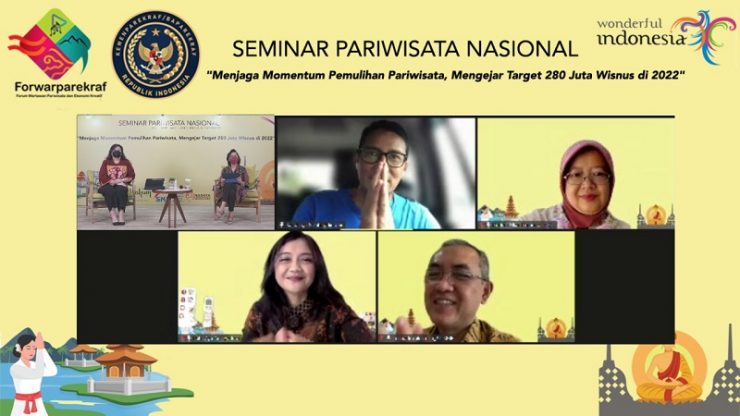EVEN two years since the COVID-19 pandemic has hit Indonesia, the tourism and creative economy sectors are among the sectors worst affected by various restrictions imposed to prevent the spread of the COVID-19 virus.
One real indicator can be seen from the decline in foreign tourist arrivals. The Central Statistics Agency (BPS) noted that in 2020 the number of foreign tourists was 4.05 million people or 25% of the total 2019 foreign tourist visits which reached 16.1 million.
The decline continued in the second year of the pandemic, where it was recorded that throughout 2021 the number of foreign tourist visits was only 1.6 million, down 61.57% compared to 2020. The government’s move to open Bali and Batam to foreign tourists in October 2021 was also blocked by the spread of variants. new Omicron since late 2021.
With pandemic conditions that are often unpredictable and full of uncertainty, the movement of domestic tourists is key. It is domestic tourists who play a role as a locomotive in efforts to recover Indonesia’s tourism sector and creative economy from the pandemic.
According to the Minister of Tourism and Creative Economy, Sandiaga Uno in his remarks at the National Tourism Seminar with the theme “Maintaining Tourism Recovery Momentum, Pursuing the Target of 280 million Domestic Tourists in 2022” on Tuesday (2/15), said 2022 will be the year of recovery for the tourist market.
Sandiaga remarked that foreign tourist visits this year will be supported by various international events such as the MotoGP in Mandalika, West Nusa Tenggara (NTB) in March 2022.
“But in 2023 I am increasingly convinced that this momentum will be further developed, and the high enthusiasm of foreign tourists has become the driving force for the tourism sector and the creative economy to date,” he said in a seminar organized by the Tourism and Creative Economy Journalists Forum (Forwaparekraf) on a hybrid basis.
Sandiaga explained the various strategies that will be carried out in the year of tourism recovery, including the restoration of the tourist market through organizing events and the restoration of the tourism industry by adapting health protocols.
“We will also restore tourism in Bali, the Riau Islands and other leading destinations,” he added.
Meanwhile, the Deputy for Strategic Studies of the Ministry of Tourism and Creative Economy, Kurleni Ukar explained, the target for foreign tourists has changed in line with changes in the calculation method carried out by the Central Statistics Agency (BPS). Where, since 2019 the calculation has been carried out using the Mobile Positioning Data method or based on the movement of the device.
With this change, the estimated number of foreign tourists in 2021 will reach 525 million movements and is projected to increase to 550 million movements this year.
According to Kurleni, in the last few months the room occupancy rate has shown an increase which indicates that foreign tourists have moved and are starting to recover. In general, the mobility of Indonesian people to tourist attractions has started to return to normal since October 2021. Domestic tourist travel is dominated by travelers from Java-Bali.
On the same occasion, General Chairperson of the Indonesian Travel Agent Association (Astindo), Pauline Suharno mentioned a number of challenges that are still being faced by domestic tourism. These include connectivity challenges, flight capacity, including price issues.
“Flight capacity is still a challenge, especially during the pandemic. Currently there are not too many flights. For example, I flew from Jakarta to Manado, it cost around IDR3.7 million. If people don’t have urgent interests, many prefer to go abroad, which is more economical,” she said.
Likewise, Group Vice President Marketing and Communication Smailing Tour and Travel Service, Putu Ayu Aristyadewi added, with the current conditions, his party implemented a strategy to reach a more segmented and targeted market. For example, the elderly segment, millennial youth, and families.
“We also place more emphasis on unique experience-based products and can only be obtained through travel agents,” she explained.
Furthermore, Minister Sandiaga Uno stated that currently there is a paradigm shift towards quality tourism development that is more focused on sustainable tourism. This means that we must have the provision of basic infrastructure and supporting tourism.
Along with the incessant development of tourist villages, one of the supporting tourism facilities that is also encouraged is the development of accommodation in the form of homestays.
To support this, PT Sarana Multigriya Finansial or SMF since 2018 has distributed homestay financing. SMF Director of Operations and Finance Trisnadi Yulrisman said homestay financing targets all tourism activists in tourist villages.
“They can use the funds to build homestays, renovate houses or rooms that can be used by tourists,” he said on the same occasion.
Trisnadi revealed that the funds allocated for this program reached IDR20.2 billion and around IDR8.2 billion has been realized with a total of 100 debtors. We set a very low interest rate, which is flat and fixed at 3% per year, with a maximum ceiling of IDR150 million per house and a tenor of 1-10 years.
Trisnadi added that currently there are 12 tourist villages that have received financing facilities from SMF. These include Samiran Tourism Village, Nglanggeran, Kuta Mandalika, Sembalun, Mertak, Bangsring. For this year, the state company is targeting five new locations, including in Likupang, Labuan Bajo, Banda Naira to Papua. [traveltext.id]
















